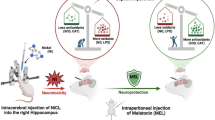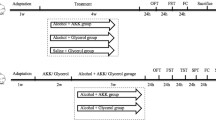Abstract
We investigated the effects of lamotrigine, aripiprazole and escitalopram administration and experimental depression on lipid peroxidation (LP) and antioxidant levels in cortex of the brain in rats. Forty male wistar rats were randomly divided into five groups. First group was used as control although second group was depression-induced group. Aripiprazole, lamotrigine and escitalopram per day were orally supplemented to chronic mild stress (CMS) depression-induced rats constituting the third, fourth and fifth groups for 28 days, respectively. Depression resulted in significant decrease in the glutathione peroxidase (GSH-Px) activity, reduced glutathione and vitamin C of cortex of the brain although their levels and beta-carotene concentrations were increased by the three drugs administrations to the animals of CMS induced depression group. The LP levels in the cortex of the brain and plasma of depression group were elevated although their levels were decreased by the administrations. The increases of antioxidant values in lamotrigine group were higher according to aripiprazole and escitalopram supplemented groups. Vitamin A level did not change in the five groups. In conclusion, the experimental depression is associated with elevated oxidative stress although treatment with lamotrigine has most protective effects on the oxidative stress within three medicines.

Similar content being viewed by others
Abbreviations
- CMS:
-
Chronic mild stress
- GSH-Px:
-
Glutathione peroxidase
- GSH:
-
Glutathione
- LP:
-
Lipid peroxidation
- MAO:
-
Monoaminooxidase
- MDA:
-
Malondialdehyde
- PUFAs:
-
Polyunsaturated fatty acids
- ROS:
-
Reactive oxygen species
- SSRIs:
-
Selective- serotonin reuptake inhibitors
- SOD:
-
Superoxide dismutase
References
Halliwell B, Gutteridge JMC (1999) Free radicals, other reactive species and disease. In: Halliwell B, Gutteridge JMC (eds) Free radicals in biology, medicine, 3rd edn. Oxford University Press, New York, pp 639–645
Nazıroğlu M, Şimşek M, Kutlu M (2004) Moderate exercise with dietary vitamin C and E combination protects streptozotocin- induced oxidative damage to the blood and improves fetal outcomes in pregnant rats. Clin Chem Lab Med 42:511–517
Bilici M, Efe H, Koroglu MA, Uydu HA, Bekaroglu M, Deger O (2001) Antioxidative enzyme activities and lipid peroxidation in major depression: alterations by antidepressant treatments. J Affect Disord 64:43–51
Takuma K, Baba A, Matsuda T (2004) Astrocyte apoptosis: implications for neuroprotection. Prog Neurobiol 72:111–127
Whanger PD (2001) Selenium and the brain: a review. Nutr Neurosci 4:81–97
Thase ME (2005) Bipolar depression: issues in diagnosis and treatment. Harv Rev Psychiatry 13:257–271
Maher P, Davis JB (1996) The role of monoamine metabolism in oxidative glutamate toxicity. J Neurosci 16:6394–6401
Hakkarainen R, Partonen T, Haukka J, Virtamo J, Albanes D, Lonnqvist J (2004) Is low dietary intake of omega−3 fatty acids associated with depression? Am J Psychiatry 161:567–569
Rao JS, Ertley RN, Lee HJ, Demar JC Jr, Arnold JT, Rapoport SI, Bazinet RP (2006). n-3 Polyunsaturated fatty acid deprivation in rats decreases frontal cortex BDNF via a p38 MAPK-dependent mechanism. Mol Psychiatry 12:36–46
Maes M, Christophe A, Delanghe J, Altamura C, Neels H, Meltzer HY (1999) Lowered omega3 polyunsaturated fatty acids in serum phospholipids and cholesteryl esters of depressed patients. Psychiatry Res 22:275–291
Baydas G, Kutlu S, Nazıroğlu M, Canpolat S, Sandal S, Özcan M, Keleştimur H (2003) Inhibitory effects of melatonin on lipid peroxidation induced by intracerebroventricularly administered homocysteine. J Pineal Res 34:36–39
Nazıroğlu M. (2006). Effects of physical exercise with a dietary vitamins C and E combination on oxidative stress in muscle, liver and brain of streptozotocin- induced diabetic pregnant rat. In: Braunstain MH (ed), Vitamin E: New Research. Nova Science Publishers Inc, NY USA, pp 69–83
Özmen I, Naziroglu M, Alici HA, Sahin F, Cengiz M, Eren I (2007) Spinal morphine administration reduces the fatty acid contents in spinal cord and brain by increasing oxidative stress. Neurochem Res 32:19–25
Eren I, Nazıroğlu M, Demirdaş A, Çelik O, Uğuz AC, Altunbaşak A, Özmen I, Uz E (2007) Venlafaxine modulates depression-induced oxidative stress in brain and medulla of rat. Neurochem Res 32: (in press)
Cyranowski JM, Marsland AL, Bromberger JT, Whiteside TL, Chang Y, Matthews KA (2007) Depressive symptoms and production of proinflammatory cytokines by peripheral blood mononuclear cells stimulated in vitro. Brain Behav Immun 21:229–237
Andreasson A, Arborelius L, Erlanson-Albertsson C, Lekander M. (2007) A putative role for cytokines in the impaired appetite in depression. Brain Behav Immun 21:147–152
Kökçam İ, Nazıroğlu M (2002) Effects of vitamin E supplementation on blood antioxidants levels in patients with Behçet’s disease. Clin Biochem 35:633–639
Chen F, Larsen MB, Sanchez C, Wiborg O (2005) The S-enantiomer of R,S-citalopram, increases inhibitor binding to the human serotonin transporter by an allosteric mechanism Comparison with other serotonin transporter inhibitors. Eur Neuropsychopharmacol 15:193–198
Patkar AA, Peindl K, Mago R, Mannelli P, Masand PS (2006). An open-label, rater-blinded, augmentation study of aripiprazole in treatment-resistant depression. Prim Care Companion J Clin Psychiatry 8:82–87
Worthington JJ 3rd, Kinrys G, Wygant LE, Pollack MH. (2005). Aripiprazole as an augmentor of selective serotonin reuptake inhibitors in depression and anxiety disorder patients. Int Clin Psychopharmacol 20:9–11
Bourin M, Masse F, Hascoet M (2005) Evidence for the activity of lamotrigine at 5-HT(1A) receptors in the mouse forced swimming test. J Psychiatry Neurosci 30:275–282
Grippo AJ, Moffitt JA, Johnson AK (2002). Cardiovascular alterations and autonomic imbalance in an experimental model of depression. Am J Physiol Regul Integr Comp Physiol 282:R1333–R1341
Grippo AJ, Beltz TG, Johnson AK (2003) Behavioral and cardiovascular changes in the chronic mild stress model of depression. Physiol Behav 78:703–710
Muscat R, Willner P (1992) Suppression of sucrose drinking by chronic mildunpredictable stress: a methodological analysis. Neurosci Biobehav Rev 16:507–517
Placer ZA, Cushman L, Johnson BC (1966) Estimation of products of lipid peroxidation (malonyl dialdehyde) in biological fluids. Anal Biochem 16:359–364
Sedlak J, Lindsay RHC (1968) Estimation of total, protein bound and non-protein sulfhydryl groups in tissue with Ellmann’ s reagent. Anal Biochem 25:192–205
Lawrence RA, Burk RF (1976) Glutathione peroxidase activity in selenium-deficient rat liver. Biochem Biophys Res Commun 71:952–958
Lowry OH, Rosebrough NJ, Farr AL, Randall RJ (1951) Protein measurement with the Folin-Phenol reagent. J Biol Chem 193:265–275
Suzuki J, Katoh N (1990) A simple and cheap method for measuring vitamin A in cattle using only a spectrophotometer. Jpn J Vet Sci 52:1282–1284
Jagota SK, Dani HM (1982) A new colorimetric technique for the estimation of vitamin C using Folin phenol reagent. Anal Biochem 127:178–182
Sierra-Honigmann MR, Murphy PA. (1992) Suppression of interleukin−1 action by phospholipase-A2 inhibitors in helper T lymphocytes. Pept Res 5:258–261
Nunez MJ, Balboa J, Rodrigo E, Brenlla J, Gonzalez-Peteiro M, Freire-Garabal M (2006) Effects of fluoxetine on cellular immune response in stressed mice. Neurosci Lett 396:247–251
Atmaca M, Tezcan E, Kuloglu M, Ustundag B, Tunckol H (2004) Antioxidant enzyme and malondialdehyde values in social phobia before and after citalopram treatment. Eur Arch Psychiatry Clin Neurosci 254:231–235
Nieuwstraten C, Labiris NR, Holbrook A (2006) Systematic overview of drug interactions with antidepressant medications. Can J Psychiatry 51:300–316
Yamada M, Yamada M, Yamazaki S, Takahashi K, Nara K, Ozawa H, Yamada S, Kiuchi Y, Oguchi K, Kamijima K, Higuchi T, Momose K (2001) Induction of cysteine string protein after chronic antidepressant treatment in rat frontal cortex. Neurosci Lett 301:183–186
Maes M, De Vos N, Pioli R, Demedts P, Wauters A, Neels H, Christophe A (2000) Lower serum vitamin E concentrations in major depression Another marker of lowered antioxidant defenses in that illness. J Affect Disord 58:241–246
Muth EA, Haskins JT, Moyer JA, Husbands GE, Nielsen ST, Sigg EB (1986) Antidepressant biochemical profile of the novel bicyclic compound Wy-45,030, an ethyl cyclohexanol derivative. Biochem Pharmacol 35:4493–4497
Czernichow S, Hercberg S (2001) Interventional studies concerning the role of antioxidant vitamins in cardiovascular diseases A review. J Nutr Health Aging 5:188–195
Bolden-Watson C, Richelson E (1993). Blockade by newly-developed antidepressants of biogenic amine uptake into rat brain synaptosomes. Life Sci 52:1023–1029
Acknowledgement
Authors wish to thank A. Cihangir Uğuz and Ömer Çelik for excellent help on the analysis of antioxidant parameters.
Author information
Authors and Affiliations
Corresponding author
Rights and permissions
About this article
Cite this article
Eren, İ., Nazıroğlu, M. & Demirdaş, A. Protective Effects of Lamotrigine, Aripiprazole and Escitalopram on Depression-induced Oxidative Stress in Rat Brain. Neurochem Res 32, 1188–1195 (2007). https://doi.org/10.1007/s11064-007-9289-x
Received:
Accepted:
Published:
Issue Date:
DOI: https://doi.org/10.1007/s11064-007-9289-x




